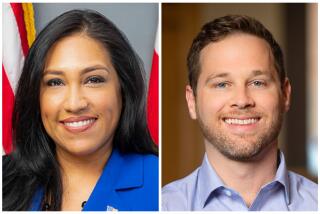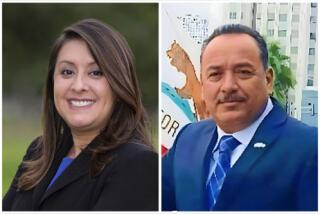Safe Seats Mean Few Voters Get Real Choice
If the political experts are right, only a relative handful of Californians will have a real choice on Nov. 5 when they pick who will represent them in the Legislature and Congress next year.
Of more than 150 seats at stake in the state Senate, Assembly and the House of Representatives, no more than 10 are rated by many political professionals, analysts and academics as genuinely contested.
Put another way, about 140 districts are safe from competition by the opposing party, a circumstance that could persist in certain parts of the state for the next decade.
In the Assembly, all 80 seats are up for election -- 32 of them with no incumbent running -- but only about half a dozen are seriously contested, most experts agree. Of the 53 House districts, they say only one is a genuine fight. Only one of the 20 state Senate offices up for election is considered to be in earnest contention.
Most of the action this year is in the Central Valley. It is the site of the single hot House race for the seat once held by Rep. Gary Condit, the only contested state Senate election and a handful of competitive Assembly battles: in the 10th, 17th, 26th and 30th districts. Winning the 15th District seat in neighboring Contra Costa County is a high priority for both parties.
In the south, close competitions are being waged in races for two other open Assembly seats: the 78th District in San Diego County and the 80th in Imperial and Riverside counties.
Why so few competitive races elsewhere in California? Blame the Legislature, which realigned political boundaries last year in what is known as redistricting, the once-a-decade drawing of new lines to reflect population changes reported in the U.S. census.
In a rare agreement, the Democratic and Republican parties reached a deal in which the lines were drawn to preserve the partisan makeup of the two houses of the Legislature and the congressional delegation.
The result was to assure that Democrats would remain the majority party and Republicans, a shrinking minority, would slip no further for the next few elections at least.
“This is a sweetheart deal that cements everyone in place,” said Tony Quinn, a Republican commentator who used to write redistricting plans for the Assembly GOP.
The realignment represents “a detriment to democracy, but it certainly is not a detriment to the two parties,” Quinn said.
Many political experts predicted that the lack of competitive races, and a resulting lack of active campaigning, would further erode voter interest and contribute to what many fear will be a record low turnout in California.
But in at least some of the races deemed noncompetitive, the candidates are hard at work wooing voters.
The politically moderate 36th Congressional District in the South Bay, for example, was redrawn to favor the reelection of Rep. Jane Harman (D-Venice).
But Harman, saying she takes nothing for granted, has been making trips home from Washington every weekend, holding round-table discussions on the local economy, working to settle the labor dispute that crippled the area’s harbors and trying to help Los Angeles County officials resolve a health crisis that threatens to close Harbor-UCLA Medical Center. Her campaign has been busy telephoning voters.
Her Republican challenger, Stuart Johnson, an attorney who lives in Manhattan Beach, has been walking precincts daily for several weeks, meeting with area Rotary clubs and chambers of commerce and raising enough money to employ a full-time campaign staff of four.
“I believe there is more interest in this race than the so-called experts think,” said Johnson, noting that he and Harman were scheduled to debate at least three times before election day.
Professor Tim Hodson of the Center for California Studies at Cal State Sacramento said that if the public perceives that redistricting has preordained an outcome of the election, “it will have an adverse effect on voter turnout and, in a general sense, on the health of the electoral system.”
But Hodson, who formerly drew redistricting plans for the Senate, said the “shelf life” of a redistricting program is limited and its partisan effectiveness gets diluted in time, as population shifts gradually blunt the district mapmakers’ handiwork.
Assembly Speaker Herb Wesson of Culver City agreed.
“Nothing is permanent,” said Wesson, whose Democrats dominate the Assembly 50 to 30, four short of the two-thirds majority needed to pass budgets and other major legislation without Republican help.
Even with only a handful of competitive Assembly races, he said, a letup in campaign spending is unlikely. “We will be spending more than $12 million to try to maintain what we have and possibly get a steal or two,” Wesson said.
On the other side, the Assembly’s GOP leader, Dave Cox of Fair Oaks, who expects to be outspent, said Republicans would “spend as much as is necessary” to protect three open GOP seats and perhaps sneak up on Democrats in as many as five other districts.
“Lots of things could happen,” Cox said.
In the House, where the census produced one more California seat to bring the delegation to 53, political mapmakers aimed to see that the Republican ranks stay at 20 and that the added seat, the 39th District in southeastern Los Angeles County, goes to a Latino Democrat.
Labor leader Linda Sanchez, sister of Rep. Loretta Sanchez (D-Garden Grove), is widely expected to win the seat this fall.
But it is the Central Valley’s 18th District seat that is drawing the most attention -- and money and other help from national leaders in both major parties. The race is one of a handful around the nation that could help determine which party controls the narrowly divided House of Representatives.
Condit (D-Ceres), tainted by the scandal surrounding his relationship with murdered intern Chandra Levy, lost the primary to Assemblyman Dennis Cardoza of Merced, his onetime aide. Republicans nominated state Sen. Richard Monteith of Modesto and mounted a big voter registration drive that cut into the Democrats’ edge.
Leaders and stars from both parties have visited the district to raise money and stump for their candidates. Cardoza attracted former Vice President Al Gore, Sen. Joseph I. Lieberman (D-Conn.) and House Minority Leader Richard A. Gephardt (D-Mo.) Democratic National Committee Chairman Terry McAuliffe walked precincts with him.
Monteith drew help from House Speaker J. Dennis Hastert (R-Ill.), House Majority Whip Tom DeLay (R-Texas) and Secretary of Agriculture Ann M. Veneman, and got time -- and photographs -- with President Bush during a Bush visit.
In state Senate races, the one hot contest is being waged between Democrat Rusty Areias of Merced, a former assemblyman who resigned as state parks director to run, and a Salinas factory owner, Jeff Denham, a Republican. The winner will succeed Monteith.
(BEGIN TEXT OF INFOBOX / INFOGRAPHIC)
Some of the more noteworthy races
Congressional District 18
Dennis Cardoza, 43
Democrat
Former assemblyman
Richard Monteith, 70
Republican
State senator
Registration: 51% Democratic, 39% Republican, 8% declined to state.
Rep. Gary Condit lost his party’s nomination to Cardoza, his onetime aide, in the March primary. Democrats still hold the edge in the district, but the gap has narrowed slightly as Republicans have mounted a strong voter registration drive.
The outcome of this contest, viewed as the only competitive House race in California, could help decide whether the GOP maintains control of the House.
Congressional District 36
Rep. Jane Harman, 57
Democrat
Incumbent
Stuart Johnson, 30
Republican
Attorney
Registration: 45% Democratic, 33% Republican, 17% declined to state.
For years this district was so evenly divided between Republicans and Democrats that neither party could count on it. But redistricting shifted the boundaries north and substantially boosted Democratic registration.
Congressional District 39
Linda Sanchez, 33
Democrat
Attorney, labor leader
Tim Escobar, 36
Republican
Businessman, former Army officer
Registration: 55% Democratic, 27% Republican, 14% declined to state.
This seat was added to the California delegation after the 2000 census and was drawn to favor a Democratic Latino. Linda Sanchez, sister of Rep. Loretta Sanchez (D-Garden Grove), won the primary with help from her sibling’s considerable fund-raising abilities. Experts predict that they will be the first sisters to serve together in the House.
State Senate District 12
Rusty Areias, 53
Democrat
Former assemblyman, former state parks director
Jeff Denham, 35
Republican
Agricultural products manufacturer
Registration: 49% Democratic, 38% Republican, 10% declined to state.
This race is considered the only real contest for a state Senate seat this fall. Barring upsets elsewhere in California, an Areias victory would give Democrats a two-thirds majority in the upper house.
Assembly District 52
Mervyn Dymally, 76
Democrat
Former state officeholder and congressman
Mark Anthony Iles, 42
Republican
Business owner and civic activist
Registration: 74% Democratic, 8% Republican, 10% declined to state.
Dymally, once California’s highest-ranking African American officeholder, wants to come out of political retirement and return to the Assembly, where he launched his career almost four decades ago. The former state senator, lieutenant governor and congressman easily won the four-way Democratic primary.
Assembly District 80
Joey Acuna, 39
Democrat
Construction supervisor
Bonnie Garcia, 40
Republican
State senator’s legislative aide
Registration: 46% Democratic, 38% Republican, 12% declined to state.
The Republican incumbent did not seek reelection, opening the door for a Latino in this border district. Both parties are pushing hard to win this open seat. Redistricting markedly improved the Democrats’ chances by taking away most of the district’s heavily Republican communities.
More to Read
Get the L.A. Times Politics newsletter
Deeply reported insights into legislation, politics and policy from Sacramento, Washington and beyond. In your inbox three times per week.
You may occasionally receive promotional content from the Los Angeles Times.











